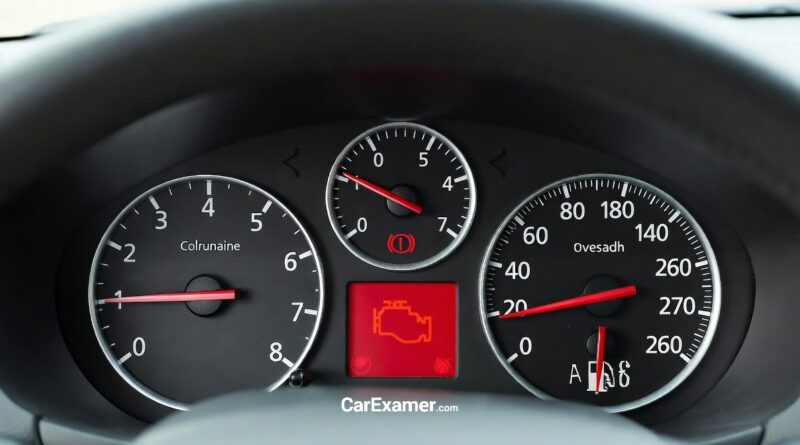Will a Car Fail MOT with the Engine MIL On?
When the engine management light (MIL) appears on your dashboard, it usually means something is wrong with the engine or emissions system. Many drivers ask whether their car can still pass the MOT test if the light is on. In the UK, MOT testers check dashboard warning lights, including the engine, airbag, ABS, and brake system indicators. Since the engine management light is linked to emissions and safety, car will fail mot with engine mil on. This article explains what the engine light means, how it impacts MOT tests, and the average UK repair costs.
What the Engine Management Light (MIL) Means
The Malfunction Indicator Lamp (MIL), often called the Check Engine Light, comes on when your car’s onboard computer detects a problem.
When you start your car, the MIL should turn on for a few seconds, then switch off once the engine starts. If it stays on or flashes, the system has found a fault that could affect emissions, performance, or reliability.
Common reasons include:
- A faulty oxygen (O2) sensor
- A blocked or failing catalytic converter
- A DPF or EGR valve fault
- Ignition coil or misfire issue
- Leaking or loose fuel cap
- Airflow or fuel system sensor faults
Will a Car Fail MOT with the Engine Light On?
Yes, your car will fail its MOT if the engine management light is on.
According to the DVSA (Driver and Vehicle Standards Agency) MOT inspection guidelines, an illuminated MIL is classified as a major defect.
This rule applies to:
- Petrol cars registered from 2001 onwards
- Diesel cars registered from 2004 onwards
If the MIL does not come on at all when you turn on the ignition, that can also lead to a failure because the tester cannot confirm the system is working correctly.
Common Causes of the Engine Light and Typical UK Repair Costs
| Cause | Description | Average UK Repair Cost |
|---|---|---|
| Faulty Oxygen Sensor | Incorrect air-fuel readings | £120 – £250 |
| Catalytic Converter Failure | Poor emissions performance | £400 – £900 |
| DPF Blockage (Diesel) | Exhaust filter clogged | £250 – £600 |
| Ignition Coil Failure | Engine misfire | £100 – £200 |
| EGR Valve Fault | Stuck or carboned valve | £200 – £400 |
| Fuel Cap Leak | System pressure loss | £20 – £50 |
| Wiring or Sensor Fault | Electrical or connection issue | £100 – £300 |
What Happens During the MOT
During your MOT, the tester will:
- Turn on the ignition and check that the MIL light illuminates.
- Start the engine and confirm that the light goes out.
- If the light stays on or flashes, it is recorded as a major defect, and the car automatically fails.
You will need to fix the problem and retest the car before it can legally be driven again.
How to Fix the Engine Light Before MOT
- Scan for error codes with an OBD2 diagnostic tool or garage equipment.
- Repair or replace the faulty part causing the code.
- Clear the code and check that the light remains off.
- Drive the car for several miles to let the ECU recheck the system.
A professional diagnostic test usually costs £50–£80 in the UK, and many garages can carry out same-day repairs.
Is It Safe to Drive with the Engine Light On?
It depends on the light’s behaviour:
- Solid light: Usually safe to drive for short distances but should be checked soon.
- Flashing light: Stop driving immediately, as this indicates a severe engine or emissions fault.
Driving with the light on for too long can cause expensive damage to the catalytic converter, spark plugs, or DPF.
How to Prevent Engine Light Problems
- Service your car regularly to keep sensors and fuel systems clean.
- Use high-quality fuel and avoid running the tank too low.
- Replace filters and spark plugs as recommended.
- Avoid short journeys, especially with diesel vehicles, to prevent DPF blockages.
MOT and Pre-Purchase Inspection Advice
If you are buying a used car with the MIL on, it may indicate underlying faults. Always request a diagnostic report or arrange a CAREXAMER pre-purchase inspection to identify the problem before buying.
For MOT tests, a glowing or flashing MIL on cars made after 2001 (petrol) or 2004 (diesel) will cause an automatic fail.
The only way to pass is to repair the fault and confirm that the system is working correctly.
Summary of Common Engine MIL Problems
| Fault | Symptom | UK Repair Cost |
|---|---|---|
| Oxygen Sensor | Poor fuel economy | £120–£250 |
| Catalytic Converter | Failed emissions | £400–£900 |
| EGR Valve | Rough idle, poor performance | £200–£400 |
| Ignition Coil | Misfire or hesitation | £100–£200 |
| DPF Blockage | Smoke or limp mode | £250–£600 |
| Fuel Cap Leak | Warning light only | £20–£50 |
Conclusion
A car will fail its MOT if the engine management light is on, as it signals an emissions or performance fault.
Typical UK repair costs range from £100 for a simple sensor replacement to about £900 for catalytic converter repairs.
To avoid an MOT failure, have the system scanned early, fix the issue, and make sure the light goes out before your test.
For used car buyers, booking a CAREXAMER inspection is the best way to spot MIL or emissions faults before they turn into costly repairs.
Buying a used VW. Buying used vauxhall, BMW, Jaguar, Ford, Volvo, Range rover, Bentley, Aston Martin, Porsche, Ferrari, Lamborghini, Maserati, Hyundai, Tesla, Honda, Pagani

